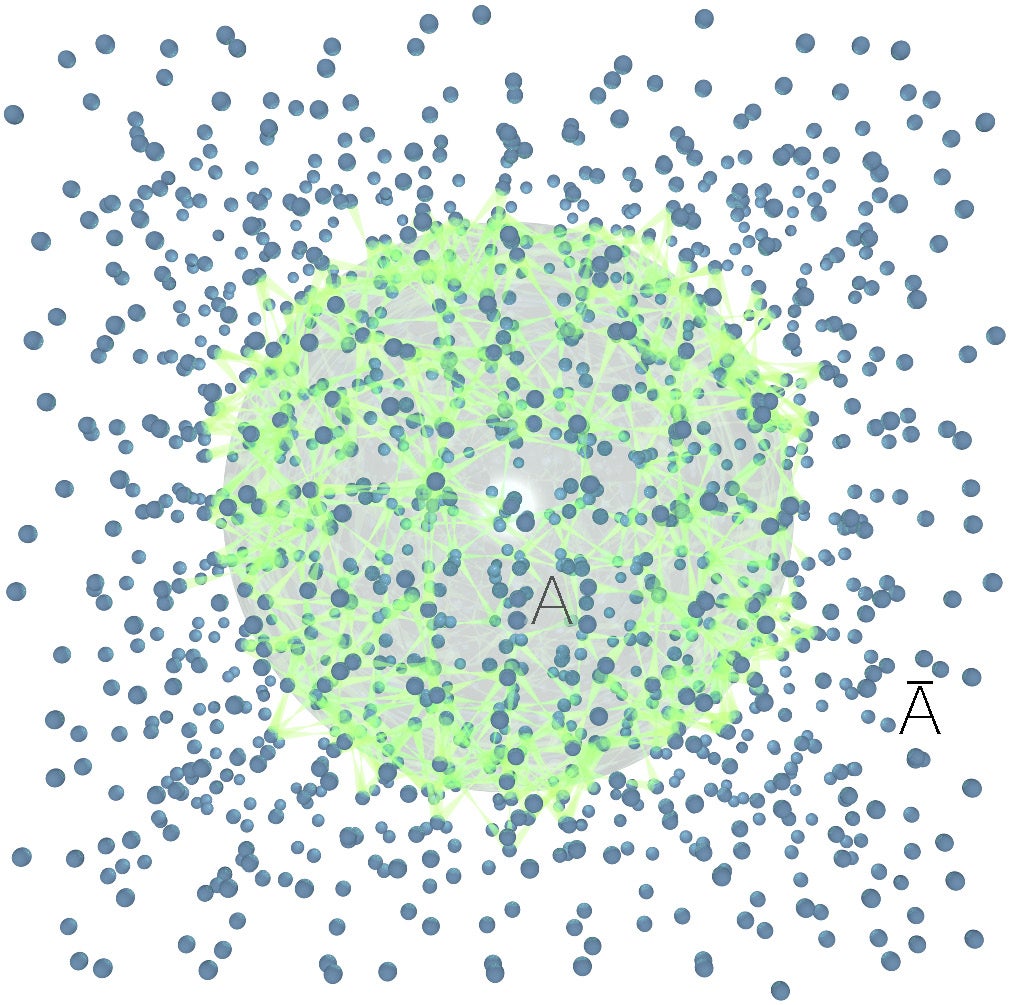IQC postdoctoral fellow Chris Herdman led a demonstration of area law scaling of entanglement entropy in a real quantum fluid for the first time.
When condensed helium is cooled to approximately two degrees Kelvin, it becomes a quantum phase of matter called a superfluid. In this state, the helium atoms move without friction and could flow without ever stopping, in principle. While entanglement is often thought of as occurring between two particles, here the researchers were studying a many-body system, meaning they had to measure entanglement between particle-filled regions of space. The researchers took a cubic box of superfluid helium-4 and divided it into a spherical sub-region and its complement. They then measured the entanglement entropy between the two regions at different system densities.

Entanglement across a spherical boundary.
Consider a classical box filled with encrypted documents. Intuitively, it is clear that if you doubled the size of the box, you could fit twice the number of documents inside, and therefore twice the information. Quantum mechanics, however, flouts intuition. Theoretical physicists Stephen Hawking and Jacob Bekenstein found out decades ago that the entropy of a black hole, a quantum box in our scenario, does not increase with volume, but rather with surface area. To double the amount our quantum box holds, we would need to double its surface area. This is the area law scaling of entropy, and it turns out that it applies to the entanglement entropy of quantum phases of matter as well, as shown in this computational experiment with superfluid helium.
“Entropy is a measure of information contained in a system,” explained Herdman. “Because entanglement relates to how information is delocalized—spread out in a system—entanglement entropy is a measure of how quantum information is delocalized in a system.” The area law scaling of entanglement entropy then, describes the strength of the entanglement entropy as scaling with the bounding surface of two entangled regions.
In the past, the area law scaling of entanglement entropy in matter has only been studied either in simplified qualitative models that do not predict or precisely describe experiments, or more recently, in experimental implementations that use artificially created systems. IQC faculty member Rajibul Islam and his team were one of the first groups to experimentally measure entanglement entropy in a many-body system, which they achieved using an artificial system in 2015.
After years of adapting and developing numerical methods to quantitatively study superfluid helium and entanglement entropy, Herdman and his collaborators, IQC affiliates and University of Waterloo faculty members Pierre-Nicholas Roy, Department of Chemistry, Roger Melko, Department of Physics and Astronomy and Perimeter Institute for Theoretical Physics, as well as Adrian Del Maestro, Department of Physics, University of Vermont, demonstrated the area law in a real, natural system for the first time. The paper Entanglement area law in superfluid 4He published in Nature Physics March 13, showed that entanglement between the sphere and complement of superfluid helium was dominated by an area law (like our quantum box), not a volume law (like our classical box). The researchers also demonstrated that they could control entanglement between the sub-regions by changing the pressure of the system, a simple variable for experimentalists to control.
In the future, Herdman hopes to explore beyond the area law. “It turns out that fundamental aspects of the physics of many-particle systems are encoded in the entanglement entropy. So for example, there is expected to be what is essentially a fingerprint of superfluidity in the entanglement entropy of our helium system. Other physical features of a system can show up there too,” but it will take more precise calculations and larger systems to study this phenomenon. Some of the system aspects expected to be encoded in the entanglement entropy could be related to exotic theories such as conformal field theory.
“And that’s the thing that’s weird,” says Herdman. “There are no obvious connections between black holes and helium, or conformal field theory and helium. It’s the universality of physics, where not only the area law, but other features of physics are common to very different systems.”